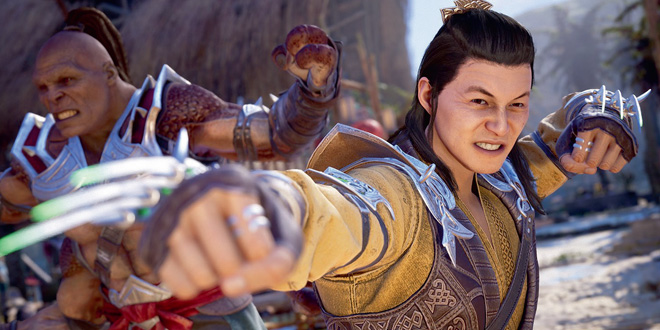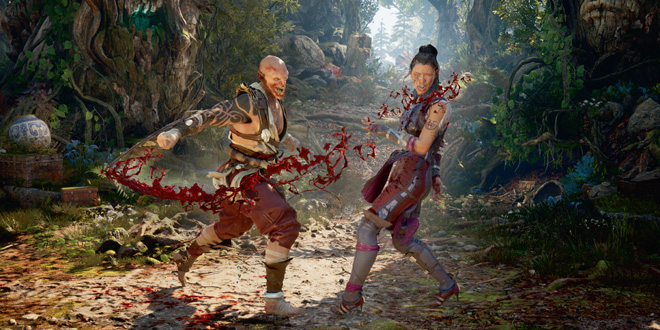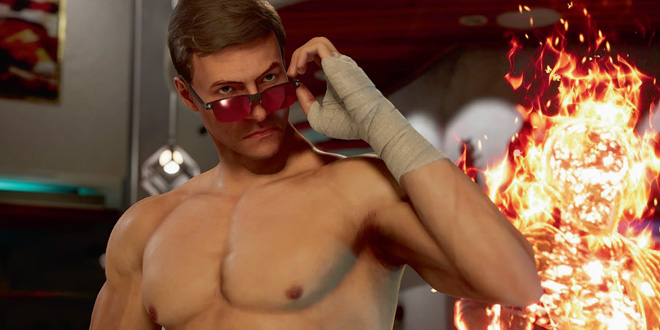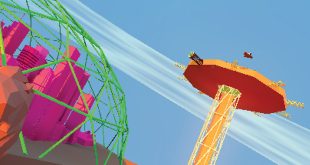Ed Boon, Chief Creative Officer at NetherRealm Studios and co-creator of Mortal Kombat, tells Vince Pavey, defender of Earthrealm, how they created a brand-new universe after 30 years. Thankfully, there were no fatalities, although there are plenty in the video game.
The first Mortal Kombat game was released by Midway back in 1992, and set the world of arcade fighting games ablaze with a high-quality competitor to the popular Street Fighter 2. It amped up the blood and violence to such a crescendo that it was partly responsible for 1993’s US congressional hearings into regulating the output of the games medium. It was, to put it simply, a phenomenon, and left an indelible mark on video games — and then there were the sequels!
After surviving government intervention, several more games were developed over the subsequent decades, each expanding upon the series’ epic lore as well as introducing new characters to take part in beating the ever-loving crap out of each other.
Now, after 11 entries and the creation of almost 100 characters, the current stewards of the franchise over at NetherRealm Studios, still led by Mortal Kombat co-creator Ed Boon, have decided to start fresh. But where does the new story start?
“The main protagonist in the Mortal Kombat saga has been a Shaolin Monk named Liu Kang,” explains Boon, co-creator of Mortal Kombat and chief creative officer at NetherRealm Studios. “Over the many years, Liu Kang has evolved from his humble beginnings as a Shaolin Monk, to a Fire God who eventually (literally) created his own Big Bang, starting a new universe. That new universe is where the story of Mortal Kombat 1 begins.”
That isn’t to say some familiar faces won’t show up, as much like when DC Comics did a similar reboot in the landmark crossover comic book event Crisis on Infinite Earths, the team wants to keep the fan favourites around — after giving them all a little bit of an update, of course.
“There actually aren’t that many games or other forms of media or entertainment that have been running for over 30 years,” muses Boon. “So, there aren’t many examples we could draw inspiration from. Obviously, there are some examples of others who had done similar rebooting. Star Wars, James Bond, DC, and Marvel are some that have. But for us personally, we felt like it was time to really start over with a new story. At the same time, we are fully aware of how much Mortal Kombat fans love the characters, so we decided to include reimagined versions of them in this brand new story.”

CHOOSE YOUR DESTINY
A lot of the rebooted characters are in a drastically different place compared to the previous games, but remain instantly recognizable. According to Boon, the changes were story-driven, and the team weren’t too precious about it as long as the game felt new. “It was very important for us to keep the Mortal Kombat fighters recognizable and for them to maintain their signature looks and abilities,” explains Boon. “The story obviously played a big part in how we changed their situations and relationships with each other. We were not really looking for “balance” as much as we were looking for change. We did feel that change was important to keep the story fresh and interesting. We also knew we needed to change how some of the fighters played in the game to give them a new feel as well.”
As for the approach to new fighting game mechanics, it largely came down to a process of experimentation and iteration, exploring different ideas from members of the team. Any fighting game player can tell you that when a new mechanic works, you go ‘oh of course’, and when it doesn’t, it could kill the whole thing faster than a good Fatality move, which was obviously something the studio was looking to avoid happening.
“One of the main goals we have with any Mortal Kombat game is to make it feel different from previous games,” says Boon. “We don’t want anyone feeling ‘this is the same as the last game, but with better graphics’. At the same time, we want to keep some amount of familiarity so long-time fans will feel at home. Once we got the Kameo Fighters functioning interchangeably with the main fighters – extending combos and doing other assist moves – we certainly had that ‘AHA!’ moment.” Perhaps the biggest new twist mechanic in Mortal Kombat 1 was the introduction of Kameo Fighters, an additional roster of icons from the long-running series that will lend you a special assist move at the tap of a button to extend your combo.
“The idea of Kameo Fighters came pretty early in the development of Mortal Kombat 1,” continues Boon. “There was a lot of experimentation and trial and error. It began with an idea some of the designers wanted to try, where each fighter would have their own unique assistant to help them during the fight. The assistant would normally be a small object that would follow the fighter as they fought. “One character might have a drone that would follow them around and another might have a magic orb following them. At the same time, separately, I wanted to incorporate a feature that showcased additional characters somehow in the kombat. One of the biggest strengths of Mortal Kombat is the characters. I also wanted the assist items to be interchangeable so any character could use any of them. The Kameo Fighter system is pretty much a combination of both ideas.”

GET OVER HERE
Mortal Kombat has been celebrated for the quality of its campaigns since at least 2011, and at least for our money at MCV/DEVELOP, sets the bar by which fighting games’ increasingly cinematic story modes should be judged. While the team has definitely gathered plenty of experience in the ‘finding reasons for so many life-and-death fights to happen’ arena at this point, creating the story for Mortal Kombat 1 was still a herculean effort.
“Telling an epic story that contains so many setups for fights is one of the big challenges with our single-player story mode,” says Boon. “Because the story is interactive, it needs to introduce conflict very frequently, or frequently enough to keep the player involved and engaged. Thankfully, we’ve done this a number of times now and each one of our story modes builds on the experience of our previous games. From the outline, to the script, to the sets, animations, motion capture, and the many other details, there are a ton of moving parts that contribute to putting together our story mode. It’s massive.”
While the story mode is probably always going to be the most appealing part of the package for a more casual fan of the franchise (particularly those that might be into the handful of movie adaptations) a lot of work design wise also went into a variety of additional modes and features that make the entire latest outing for the Defenders of the Realm feel more complete and polished. This includes coming up with reasons for players to come back, like unlockables.
“Mortal Kombat games always have a number of design challenges. Because we are not only a one-on-one fighting game, we have other game modes that need to be built around our core fighting mechanic,” explains Boon.
“We have an entire design team that is working on the various modes of the game. These include the single player experiences like our story mode and Invasions. Additionally, there are a number of multiplayer and online game modes, a high level ‘metagame’ for players to immerse themselves in that often involves collection, RPG elements, and customization. All of these features need to work together to define and compliment the complete package of Mortal Kombat 1.”

WHO’S NEXT
A fact you may not know about Mortal Kombat, was that the fighting game originally started out as a pitch for an arcade adaptation of the video game Universal Soldier, and then later Bloodsport, both of which would’ve starred a digitised version of Jean-Claude Van Damme.
Even after those licensing deals fell through, and the game had to morph into its own thing, there was some hope that ‘The Muscles from Brussels’ would then be willing to play movie star Johnny Cage, although alas, that seemed like it was not to be either. That is, until now, when JCVD has done just that, appearing in Mortal Kombat 1 as an optional skin for the rebooted character and joining a long line of pop-culture icon guest stars.
“Over the years we’ve had a number of ‘bucket list’ guest characters and actors that we’ve wanted to see in Mortal Kombat,” explains Boon. “We have been very fortunate to have gotten a number of the biggest 80s and 90s action stars in our games. Honestly, we never gave up on getting Jean-Claude Van Damme in Mortal Kombat, going back to 1992. We’ve always been big fans of his and persisted over the decades. Somehow the planets never lined up until Mortal Kombat 1, which does feel like there’s some kind of destiny going on.”
This is just the icing on the cake though, as fans and newcomers alike seem like they would be happy with Mortal Kombat 1 even without the option.
“The reaction to Mortal Kombat 1 has been fantastic. Players love our story mode with its insane last chapter,” enthuses Boon. “It’s so fun to see players finding great combinations of their main and Kameo fighters and discovering combos that we didn’t even think of. Players are still discovering new things they can do in the game.”
As for what’s next for Mortal Kombat? A lot. But no sequels just yet, outside of the one on the way for the most recent live action movie adaptation.
“Like we’ve done in the past, we are going to be supporting Mortal Kombat 1 for a long time,” confirms Boon. “We have new guest fighters like Omni-Man, Peacemaker, and Homelander coming soon, along with more Mortal Kombat characters joining the roster like Quan Chi, Ermac, and Takeda Takahashi. There is so much more Mortal Kombat 1 to come!”

 MCV/DEVELOP News, events, research and jobs from the games industry
MCV/DEVELOP News, events, research and jobs from the games industry




